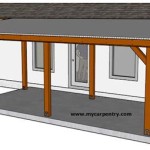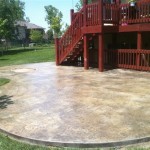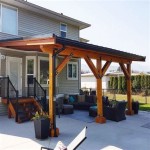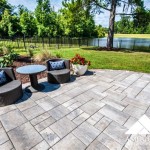Do You Have To Slope A Paver Patio Slab? Understanding Patio Drainage
The construction of a paver patio involves several crucial steps to ensure its longevity, stability, and functionality. Among these considerations, the issue of sloping the patio surface often arises, leading many homeowners and landscape contractors to question its necessity. The answer is generally yes, a paver patio should be sloped. The purpose of this slope is to facilitate proper drainage, preventing water from pooling on the surface and potentially causing damage or creating unsafe conditions. This article will delve into the reasons behind this recommendation, exploring the potential consequences of inadequate drainage and outlining the best practices for achieving effective slope within a paver patio installation.
The discussion will address the fundamental principles of water management in hardscape design, examining the impact that standing water can have on the integrity and aesthetics of a paver patio. Furthermore, this exploration will cover the various methods used to calculate and implement the appropriate slope, taking into account factors such as the size of the patio, the type of pavers used, and the surrounding landscape. By understanding the underlying rationale and the practical techniques involved, individuals can make informed decisions regarding the construction of their paver patios and ensure their long-term performance.
The Critical Role of Drainage in Paver Patio Longevity
The primary justification for sloping a paver patio stems from the need to manage water effectively. Without a proper slope, rainwater, melting snow, and irrigation runoff are likely to accumulate on the patio surface. This standing water can lead to a number of detrimental effects, impacting both the structural integrity of the patio and its overall aesthetic appeal.
One of the most significant concerns associated with standing water is the potential for erosion. Water can seep into the joints between the pavers, gradually washing away the sand or polymeric sand that stabilizes them. Over time, this erosion can lead to uneven paver surfaces, creating tripping hazards and compromising the overall stability of the patio. Furthermore, the displacement of jointing material allows weeds and other vegetation to take root, further degrading the patio's appearance and structural integrity.
In colder climates, the freeze-thaw cycle presents an even greater threat. When water penetrates the paver joints and freezes, it expands, exerting pressure on the surrounding pavers. This pressure can cause the pavers to crack, shift, or even heave out of place. Repeated freeze-thaw cycles can exacerbate this damage, leading to significant deterioration of the patio over time. Proper drainage, achieved through sloping, minimizes the amount of water that can penetrate the paver joints, thereby reducing the risk of freeze-thaw damage.
Beyond structural concerns, standing water can also contribute to aesthetic issues. It can promote the growth of algae, moss, and other unsightly organisms, staining the paver surface and creating a slippery, potentially hazardous environment. These organisms thrive in damp conditions, and their presence can detract from the beauty of the patio and require frequent cleaning and maintenance.
Therefore, providing adequate drainage through proper sloping is essential for maintaining the long-term durability, stability, and appearance of a paver patio. Failing to address this crucial aspect of patio construction can lead to costly repairs and premature deterioration.
Determining the Appropriate Slope for a Paver Patio
Achieving effective drainage requires careful planning and execution of the patio's slope. The optimal slope will depend on several factors, including the size of the patio, the type of pavers used, the intended use of the patio, and the surrounding landscape. Generally, a minimum slope of 1/8 inch per foot is recommended for paver patios. This means that for every foot of horizontal distance, the patio surface should drop 1/8 of an inch in elevation.
For larger patios, a slightly steeper slope may be necessary to ensure adequate drainage. The goal is to direct water away from the patio surface quickly and efficiently, preventing it from pooling in low-lying areas. In some cases, particularly where the patio is adjacent to a building foundation, a steeper slope of up to 1/4 inch per foot may be recommended to prevent water from seeping into the foundation.
The type of pavers used can also influence the appropriate slope. Pavers with textured surfaces or wider joints may require a slightly steeper slope to facilitate runoff. Conversely, pavers with smooth surfaces and tight joints may require a less aggressive slope. It is essential to consider the specific characteristics of the chosen pavers when determining the optimal slope for the patio.
The intended use of the patio should also be taken into account. If the patio will be used for dining or other activities that require a level surface, a less aggressive slope may be preferred. However, it is crucial to strike a balance between comfort and functionality, ensuring that adequate drainage is still provided. In such cases, careful planning and execution are essential to minimize the impact of the slope on the usability of the patio.
Furthermore, the surrounding landscape can influence the appropriate slope. If the patio is surrounded by landscaping, it is important to ensure that the slope directs water away from the plants and towards a designated drainage area. This will prevent water from accumulating around the plants' roots and potentially causing root rot or other problems.
Accurate measurement and consistent application are critical to achieving the desired slope. Laser levels and string lines are valuable tools for ensuring that the slope is uniform and consistent across the entire patio surface. It is also essential to check the slope periodically during construction to ensure that it is within the specified tolerances.
Implementing Proper Sloping Techniques During Paver Patio Installation
The implementation of proper sloping techniques begins with the preparation of the base layer. This layer, typically composed of compacted gravel or crushed stone, provides a stable and level foundation for the pavers. The base layer should be sloped in the same direction and at the same grade as the finished patio surface. This ensures that water will drain effectively through the entire patio structure.
During the base layer preparation, it is crucial to use a level and a straight edge to ensure that the slope is consistent and accurate. Any irregularities in the base layer can translate into unevenness in the finished patio surface, compromising its appearance and functionality. Compacting the base layer thoroughly is also essential to prevent settling and shifting over time.
Once the base layer is properly prepared, a layer of bedding sand is typically applied to provide a cushion for the pavers and allow for minor adjustments in elevation. The bedding sand should be evenly distributed and compacted to create a smooth and uniform surface. The slope should be maintained throughout the bedding sand layer, ensuring that it aligns with the underlying base layer.
The pavers are then carefully placed on top of the bedding sand, following the chosen pattern and maintaining consistent spacing between the pavers. It is important to use a rubber mallet to gently tap each paver into place, ensuring that it is level and aligned with the surrounding pavers. The slope should be checked periodically during paver installation to ensure that it is being maintained.
After the pavers are installed, the joints between them are filled with sand or polymeric sand. Polymeric sand is a type of sand that is mixed with polymers, which harden when exposed to water. This helps to stabilize the paver joints and prevent erosion. The joints should be completely filled with sand or polymeric sand, and the excess should be swept away.
Finally, the patio should be thoroughly watered to compact the jointing material and activate the polymers in polymeric sand. This will help to create a strong and stable surface that will resist erosion and weed growth. Regular maintenance, including sweeping and occasional cleaning, will help to keep the patio looking its best and ensure its long-term performance.
By carefully following these steps and paying attention to detail, individuals can successfully implement proper sloping techniques and create a paver patio that is both beautiful and functional. Adequate drainage is essential for the longevity and stability of the patio, and it is well worth the effort to ensure that it is properly sloped.
In summary, the inclusion of a slope in the design and construction of a paver patio is not merely an aesthetic consideration, but a fundamental requirement for ensuring its long-term health and functionality. Addressing drainage effectively from the outset will mitigate potential problems associated with water accumulation and contribute significantly to the overall value and enjoyment of the outdoor space.

How To Lay A Stone Patio This Old House

How Do I Slope A Patio Toward One Of Its Corners Home Improvement Stack Exchange

Paver Patio Slope For Drainage How To Hardscape

Laying Patio Pavers Polycor Inc
Dammann S Garden Company Diy Series How To Install Level Pavers And Patio Stones

All The Basics Of How To Screed Lay A Paver Patio

How To Get Your Yard Leveled For Paverspavestone Brick Paving

What Is An Appropriate Paver Patio Slope Aviara Pavers

How To Lay Pavers Over Concrete A Step By Guide Diy

Your Guide To Installing A Paver Patio On Slope West Hills Masonry
Related Posts








